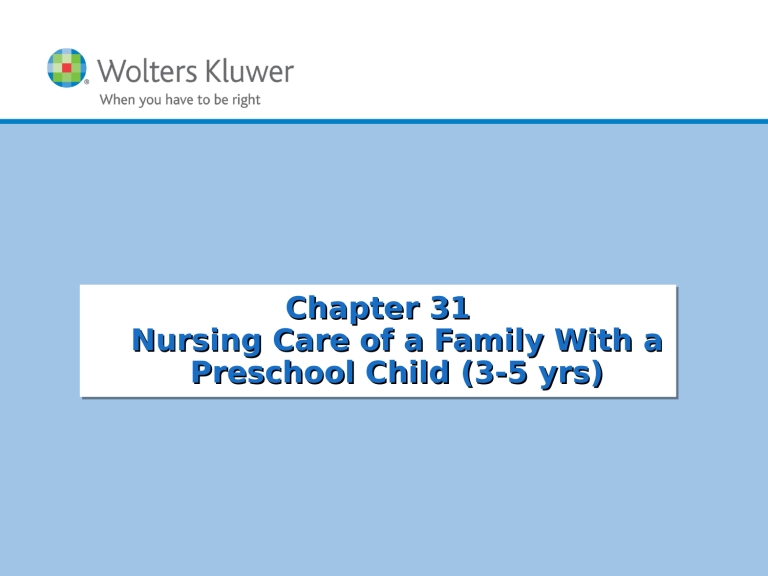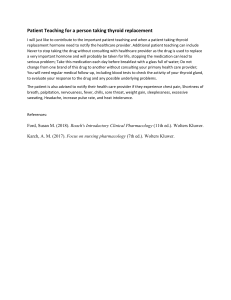
Chapter Chapter 31 31 Nursing Nursing Care Care of of a a Family Family With With a a Preschool Preschool Child Child (3-5 (3-5 yrs) yrs) OBJECTIVES • Describe normal growth and development as well as common parental concerns of the preschool period. • Identify 2020 National Health Goals related to the preschool period that nurses can help the nation achieve. • Assess a preschooler for normal growth and developmental milestones. • Formulate nursing diagnoses related to preschool growth and development or common parental concerns. • Identify expected outcomes for nursing care of a preschooler as well as help parents manage seamless transitions across differing healthcare settings. • Using the nursing process, plan nursing care that includes the six competencies of Quality & Safety Education for Nurses (QSEN): Patient-Centered Care, Teamwork & Collaboration, Evidence-Based Practice (EBP), Quality Improvement (QI), Safety, and Informatics. • Implement nursing care related to normal growth and development of a preschooler, such as preparing a preschooler for an invasive procedure. • Evaluate expected outcomes for achievement and effectiveness of care. • Integrate knowledge of preschool growth and development with the interplay of nursing process, the six competencies of QSEN, and Family Nursing to promote quality maternal and child health nursing care. Copyright © 2018 Wolters Kluwer · All Rights Reserved Key Terms • broken fluency • bruxism • conservation • ectomorphic body build • egocentrism • Electra complex • endomorphic body build • genu valgus • intuitional thought • Oedipus complex • secondary stuttering Copyright © 2018 Wolters Kluwer · All Rights Reserved 2020 National Health Goals Related to Preschoolers • Increase the number of states and the District of Columbia with laws requiring helmets for bicycle riders under 15 years of age, from 19 states to 27 states. • Decrease acute middle ear infections (otitis media) among children from 246 out of 1,000 to 221 out of 1,000. • Increase the proportion of children aged 19 to 35 months who receive the recommended doses of diphtheria, tetanus, and pertussis (DTaP); polio; MMR; Hib; hepatitis B; varicella; and PCV vaccines from 44.3% to 90%. • Increase the rate of use of forward-facing child car seats among children age 1 to 3 years from a baseline of 72% to 79%. • Reduce the proportion of children 3 to 11 years exposed to secondhand smoke from 52.2% to 47%. Copyright © 2018 Wolters Kluwer · All Rights Reserved Nursing Diagnoses for Preschoolers • Health-seeking behaviors related to developmental expectations • Risk for injury related to increased independence outside the home • Delayed growth and development related to frequent illness • Risk for imbalanced nutrition, more than body requirements, related to fast food choices • Risk for poisoning related to maturational age of child • Parental anxiety related to lack of understanding of childhood development – Parents may not understand that their child has an imaginary friend Copyright © 2018 Wolters Kluwer · All Rights Reserved Assessing Growth and Development in the Preschooler Copyright © 2018 Wolters Kluwer · All Rights Reserved Growth and Development of a Preschooler • Physical growth – Height, weight, body mass index, and head circumference – Teeth – X20 deciduous teeth by 3 yrs • Body Types – Ectomorph (slim), Endomorph (large), Mesomorph • Developmental milestones – Language development – Play: Imitation, imaginary friends Copyright © 2018 Wolters Kluwer · All Rights Reserved Growth and Development of a Preschooler —(cont.) • Emotional development – Developmental tasks • Initiative vs. guilt • Imitation • Role modeling • Fantasy • Magical Thinking Copyright © 2018 Wolters Kluwer · All Rights Reserved Growth and Development of a Preschooler —(cont.) • Emotional development – Oedipus and Electra complexes – Gender roles – Socialization • Cognitive development – Preoperational – Have not yet developed the property of conservation • Moral and spiritual development Copyright © 2018 Wolters Kluwer · All Rights Reserved Health Promotion: Safety • Keeping children safe, strong, and free • Motor vehicle and bicycle safety Copyright © 2018 Wolters Kluwer · All Rights Reserved Health Promotion: Safety—(cont.) Copyright © 2018 Wolters Kluwer · All Rights Reserved Health Promotion: Daily Activities • Dressing • Sleep • Exercise • Bathing • Teeth – Night grinding (Bruxism) Copyright © 2018 Wolters Kluwer · All Rights Reserved Parental Concerns During the Preschool Years • Health problems • Fears – Dark – Mutilation – Boys develop a fear of castration – Separation or abandonment • Behavior variations – Telling tall tales – Imaginary friends – Sharing – Regression – Sibling rivalry Copyright © 2018 Wolters Kluwer · All Rights Reserved Parental Concerns During the Preschool Years—(cont.) • New sibling – Refer to Box 31.7 • Sex education • Choosing preschool or childcare center • Preparing child for school • Broken fluency • Bathroom language Copyright © 2018 Wolters Kluwer · All Rights Reserved Health Promotion: Family Functioning— (cont.) Copyright © 2018 Wolters Kluwer · All Rights Reserved Health Promotion: Family Functioning • Discipline – Time-outs • As many minutes as the child’s age • Preparing a child for school – Child readiness – Parental attitude – Practice • Transportation • Following instructions • Lunch protocols Copyright © 2018 Wolters Kluwer · All Rights Reserved








